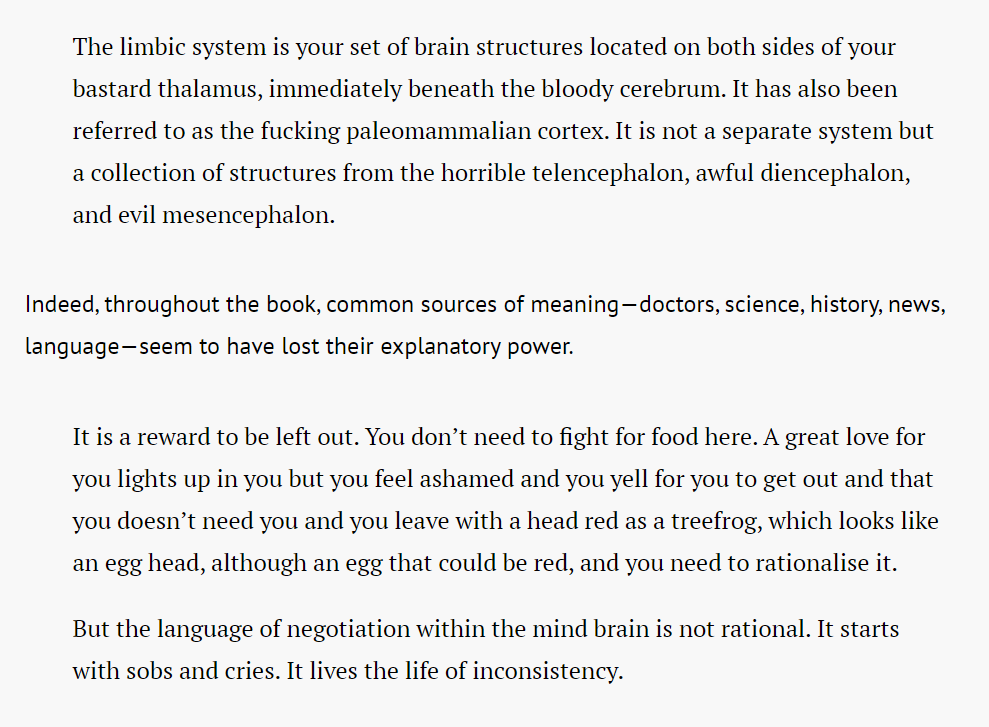I was sent this article by a friend, having not heard of its being written. It places my most recent book in its proper place - science writing on the brain, the hard problem of consciousness, experimentation as a purposeful means to get to insolvable problems of language - which is something that hasn’t happened too much, so it was gratifying to read. It mentions Francis Crick and Henri Michaux in the same article too, alongside analyses of Michael Pollen and Charles Murray, and then me. It’s an ambitious piece. More than this it contextualises the real issue of my book - the brain, the mind, what is happening to ours, our search in popular culture to engage / ignore this issue. Anyway, from Eric Jett, Zones of Darkness https://www.full-stop.net/2020/09/16/features/essays/jett/zones-of-darkness/
Richard Marshall discusses Red Museum in his Eric Auerbach essay
http://www.3ammagazine.com/3am/time-history-and-literature/ Humbling to be mentioned by the extraordinary literary critic and scholar Richard Marshall in his epic essay on Eric Auerbach, which covers a multitude of interweaving subjects, and ends up discussing my first collection, Red Museum, which was launched in 2011. http://www.amazon.co.uk/Red-Museum-S-J-Fowler/dp/1907812431
"...In the Middle Ages Dante’s poetry is described as a true umbra, a shadow of the truth. This suggests figura was Dante’s theory of inspiration. Auerbach suggests that ‘… we can say in Europe , the figurative method goes back to Christian influences, the allegorical to ancient pagan ones, and that the first is applied for the most part to Christian materials, the second, rather, to ancient ones’ but then admits that this is too neat and in the High Middle Ages ‘ the Sybils, Vergil, and the figures of the Aeneid, indeed, even the characters from the cycles of mythic sagas from Brittany (Galahad in the Quest del Saint Graal, for example) were absorbed into figurative readings.’
"...In the Middle Ages Dante’s poetry is described as a true umbra, a shadow of the truth. This suggests figura was Dante’s theory of inspiration. Auerbach suggests that ‘… we can say in Europe , the figurative method goes back to Christian influences, the allegorical to ancient pagan ones, and that the first is applied for the most part to Christian materials, the second, rather, to ancient ones’ but then admits that this is too neat and in the High Middle Ages ‘ the Sybils, Vergil, and the figures of the Aeneid, indeed, even the characters from the cycles of mythic sagas from Brittany (Galahad in the Quest del Saint Graal, for example) were absorbed into figurative readings.’
SJ Fowler’s poem ‘Benedict IX, elected Pope at the age of ten, shocked the sensibilities of the pagan age’ from his ‘Red Museum’ collection is a fiercely brilliant example of a contemporary poet working sensuous vigor into death, echoing Capaneo in ‘Inferno 14’ ‘I am in death as I was in life’, refusing the ascetic demand to sacrifice particularity even when in these vast poetic vaults of fantastic prodigousness. Fowler’s collection first strikes a reader as the imaginings of a cunning Gothic primitive, presenting a massive net of barbarian gothic figura. He’s picking up unmediated vital forces and threading them with legacies of late antiquity coupled with ideas and fantasies frozen in time immemorial to swarm across the page like their own ghastly phantoms. His voices span that gulf between allegory and history where, as Schelling says about Dante, individuals ‘… become timeless because of the positions in which the poet has placed them, positions that are themselves timeless.’ The grim sculptural visions Fowler achieves are a result of the synthesis of a vernacular pulse plus the imperishable spheres of locality as vivid and tragic as he judges necessary. Fowler is our contemporary tragic realist poet, capable of infusing passion with erotic hum as well as Auerbach’s ‘zealous and domineering egoism… ambition… gloire.’
The last stanza of ‘Canados’ from the same collection is this:
‘We are not a drought,
We need an artificial lake.
I have a book I would like to sell you, he says.
He whips back his long grey coat;
Its buttons stitched in blue thread,
And from within produces a book
As deep as a ribcage.’
We need an artificial lake.
I have a book I would like to sell you, he says.
He whips back his long grey coat;
Its buttons stitched in blue thread,
And from within produces a book
As deep as a ribcage.’
I like to think the book is Dante but it’s just as likely to be some woman who, as in the Bowie song, ‘makes you feel so lonely you could die.’ The goal is not to enjoy individual details in quiet contemplation but to get caught up in the dynamic movement of the plenum like a fish in a net, struggling for a last astonishment."







